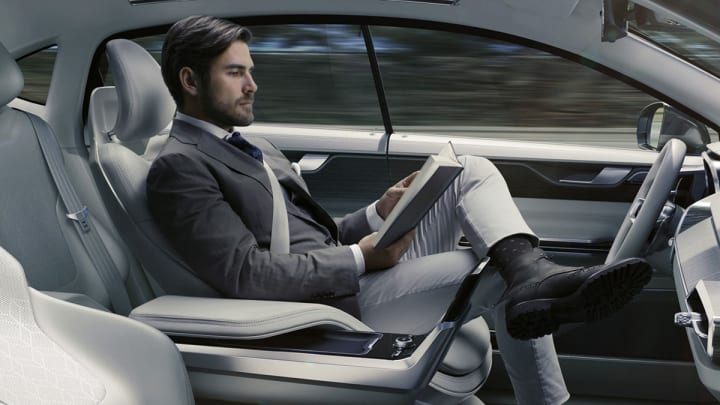AI in the Automotive Industry
What we consider a car may soon be a thing of the past with the rise of AI in the automotive industry.
The integration of artificial intelligence in the automotive industry has allowed manufacturers and consumers to redefine what it means to own a car. What we consider a car may soon be a thing of the past. Is a car still a car if you don't drive it? Up until recently, the driving experience has been the most important part of a vehicle. Every control in your car has been ergonomically designed to keep you balanced between feeling comfortable and staying focused on the road ahead. Now imagine a car with no steering wheel. Self-driving cars are already a reality with manufacturers like Tesla on the road to offering drivers the ultimate hands-off driving experience.
Artificial intelligence in the automotive industry is making dramatic changes to how we build and use our vehicles. Manufacturers are continually incorporating more artificial intelligence into every aspect of the automotive industry. Even though these technologies have begun to emerge in consumer markets around the globe, they are just the beginning of a larger revolution occurring every day in the automotive industry. To understand how we have reached this point, let us take a moment to examine the evolution of the automotive industry.
The History of the Automotive Industry

Ironically, one of our most valuable inventions, the car, has no actual inventor. There is no single individual who can be credited with this leap in transportation technology. Instead, we have many different people sharing a piece of this prize. Karl Benz, Gottlieb Wilhelm Daimler, and Nicolas Joseph Cugnot are regarded as the three primary contributors to the development of the automobile.
In 1886, the first patent for the automobile came out of Germany by Karl Benz. With a top speed of just eight mph, Karl raced across the German countryside. News spread quickly and it wasn't long before America got into the automotive industry. By 1893, American inventors were testing their own gas-powered versions of the automobile. It was not soon after that the first commercially available automobiles were being marketed to the American public.
A man by the name of Hiram Percy Maxim invented the first electronic automobile. This invention was ahead of its time, with automotive manufacturers only recently producing electric vehicles for the consumer market. If we had pursued this technology back then, the world would be a very different place.
Henry Ford is seen as the grandfather of the automotive industry. This title is fitting considering there was really not much of an automotive industry prior to him. Mr. Ford understood the valuable power of industry and marketing. He was known as a perfectionist and because of this; He often split with business partners unfavorably. The Cadillac Motor Company was originally a partnership that included Mr. Ford until a falling out occurred resulting in the formation of the Ford Motor Company.
Ford was determined to bring the automobile to the masses and after winning a court battle for the patent on automobiles, he got the ability to produce royalty free automobiles. This drove the price per vehicle down. Even after this victory, Ford still wasn't happy, if he wanted to get his cars out he needed to drop the prices of his vehicles even further. The assembly line was born out of this need for mass production. An assembly line compartmentalizes construction of a product. This allows for mass production, lower costs per product, and a specialized workforce. Assembly lines cut the build time of Ford's model-T down by 677 minutes.
This resulted in the lower prices Ford had been searching for. The Ford Motor Company flourished under this new business plan and it wasn't long before others took note. In 1908, William Durant incorporated General Motors and by 1915 Buick had become an established line in the automotive industry. By using the same assembly line production strategy, General Motors was able to stay competitive with Ford. Eventually, two brothers would branch off and form the Dodge motor company.
This is how we ended up with the big three, Ford, GM, and Chrysler. These three corporations have managed to remain the largest car manufacturers in the United States. This was not without stress. During WWII, all assembly lines were put towards the war effort. After WWII, returning soldiers came back to the states eager to spend their savings and build their new lives. This boosted automotive sales through the roof.
Artificial Intelligence Becomes a Reality

At this exact same time, a man by the name of George Devol was applying for the first robotics patents. If only he could of known how this invention would eventually lead to the use of artificial intelligence in the automotive industry. Devol had thought up the idea for robot workers after seeing a picture of an assembly line. He felt that machines were better suited for the monotonous motions of an assembly line and he set off to develop the first robot builders. Devol's first robots could only transfer an item from one place to another. These original robots could travel about 12'. The entire machine needed to have each hydraulic programmed in a joint coordination. Although time consuming, these early robots were accurate to 1/10,000 of an inch. This new super employee caught the attention of executives at Chrysler and in 1962; The first industrial robot was put in use at the New Jersey General Motors Plant.
The American car industry continued to flourish until the early 70s, when the rising cost of fuel caused a lull in production. Japan was one of the first countries, other than the US, to recognize the true potential of this new technology and the cost benefits it could provide. Unlike humans, a robot workforce never needed a day off, health benefits, or breaks. In 1970, several large Japanese corporations began building their own version of Devol's robot and in 1974, the designs for the first robot arm assembly line units began to emerge.
In the early 80s the industrial robot industry exploded. New designs and styles of robots began to emerge weekly. This led to a race to create the most efficient robot possible. These robots differed from their predecessor because they used feedback from pressure and touch sensors to help them make informed decisions. This deductive reasoning laid the foundation for artificial intelligence in the automotive industry. In 1981, Takeo Kanade changed the game forever with the invention of a direct drive arm. What Takeo did that was so revolutionary was install motors directly into the joints of the robot arm. This increased the speed and accuracy of robots. Over the following decade, the invention of smaller and more powerful computers fueled this robotic revolution. Robots began to replace humans in the car building process on a large scale. These new automated workers were able to outperform their human counterparts, as long as the task didn't require anything that the robot was not pre-programmed to handle.
As computer technology increased, more and more manufacturers began transferring to robot-based assembly lines. New high-speed computers were developed that could control multiple robots simultaneously. We tend to think of artificial intelligence (AI) as a new thing but it was the ancient Greek philosopher Socrates who originally came up with the deductive reasoning process AI computers use today.
The term artificial intelligence itself did not come around until 1950. During the 1960s, heavy research continued into the field of artificial intelligence and deductive reasoning. This is how early AI was designed to function on computers. The theory is that, since any mathematic equation can be deduced to the best answer, any computer should be able to convert a situation into a mathematical equation and using preset predetermining factors, make a well-informed decision. These early attempts at AI were met with some difficulty. It proved very hard to explain things like uncertainty and ambiguity in a mathematical format that a computer could understand.
Eventually, scientist found a workaround and by the late 80s AI computers were being used in a number of applications such as stock market analysis. These units were ridiculously expensive and because of this, only the largest corporations could have access to them. At the time, these early computers were considered AI but by today's standards, they would simply be considered deductive reasoning machines.
The first major steps to true artificial intelligence began with deep blue. Even though deep blue could not think for itself, it did have the ability to take a plethora of information and run the numbers to end up with the most statistically right decision. On may 11, 1997, Deep Blue became the first AI computer to defeat a world chess champion. AI had begun to leave its mark in the automotive industry.
In 2005, the DARPA Grand Challenge upped the ante by using an AI computer to pilot a car for 131 miles over a changing course. It wasn't but two years that later a team from CMW won the DARPA Urban Challenge. Their vehicle autonomously navigated 55 miles of busy city streets adhering to all traffic laws and avoiding any hazard encountered.
The recent boom in artificial intelligence can be traced back to the use of stronger and faster computers. These supercomputers allow data to be calculated and absorbed at a greater rate. New AI systems use a process known as Intelligent Agent. This new version of AI makes use of the added computer power to process more situational information. These new AI units can be found in every aspect of our automobiles. From their inception and design to the building and testing, all the way to how you interact with your vehicle, artificial intelligence is playing its part.
The Future of Artificial Intelligence in the Automotive Industry

AI technology has the potential to allow for a better driving experience. That is, if you can still call it driving. Features like autopilot and speech recognition are quickly making their way to the marketplace. The integration of automotive and cellular technology will make it possible to one day literally "call your ride." Imagine sending your car to pick your children up from school or catching up on some sleep while driving home from work. All these space age ideas and much more are being developed every day by auto manufacturers around the world.
The advent of 3D printing technology has the potential to take AI-powered vehicle to the next level. Much like how the assembly line helped Henry Ford introduce his model-T to the world, new manufacturing processes are sure to continue to lower the price of AI vehicles. Soon texting and driving will not be a problem at all. The new age of artificial intelligence in the automotive industry is upon us.
About the Creator
James Lizowski
Spends his days making his own Star Wars figurines. His craft has driven him to look towards the future, drawing inspiration from past technological advances.






Comments
There are no comments for this story
Be the first to respond and start the conversation.